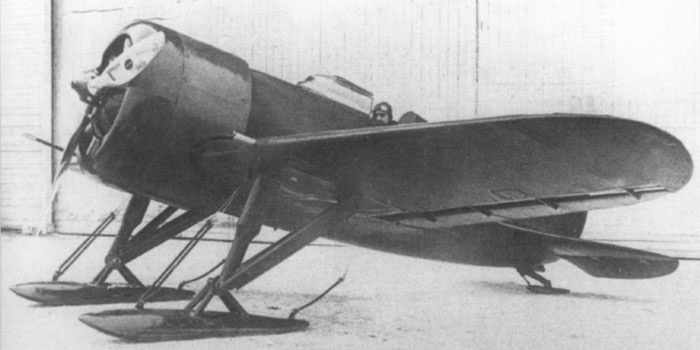
The prototype of what became the I-16 was first flown by the famous test pilot Valeriy Chkalov on 30th December 1933. It was the first cantilever monoplane fighter with enclosed canopy and retractable landing gear. It was moved by a 480 hp M-22, a Soviet-built version of the Bristol Jupiter VI
Photo: the TsKB-12 fitted with skis and a three-blades Hamilton Standard propeller, and Evgenii Chalow in the cockpit.
The typical color for many Soviet prototypes of the '30s is believed to be glossy red, without red stars or other markings. It was likely that the engine cowling was painted in different color, as on the TsKB-15 (I-17) still preserved with the original livery, that was red with blue nose, or the TsKB-30 Moskva' (TB-3) of which some pieces are still preserved and show a livery in red and dark cherry red.
About the TsKB-12, it seems to see a slight difference of shade between the cowling and the airframe; so it could have been painted red overall with blue cowling, just as the TsKB-15.(From Polikarpov I-16 fighter of Y.Gordon and K. Dexter)
Since the late 20s, Soviets started to paint their military planes with a dark gloss greenish khaki paint called Zashchitnyi, that means 'protective' because it makes the plane less visible. Available chips show a sort of olive drab, but it could have been more greenish when new.
The undersurfaces were painted in a gloss light/medium grey-blue shade. Unfortunately no reliable samples of this color are available, apart for the undersurface of the Po-2 preserved in Finland that looks greenish as the British Sky, but it is likely that this was not its original look. Chips on a Spanish I-16 show a light blue-grey-green shade not too far from Sky.
From photos, we see that it was darker than AE-9 and AII light blue, more or less as the AMT-7. Maslov described it as a light blue that turned to grey with the ageing. Hypothetically, when new it could have resembled to AMT-7 .
 camouflage olive green (zashchitnyi)
camouflage olive green (zashchitnyi)
 light grey-blue
light grey-blue
 black
black
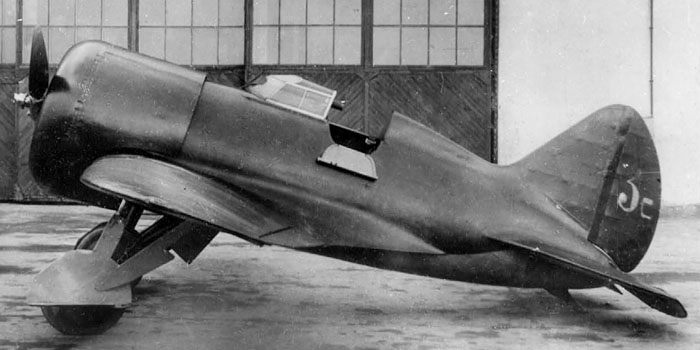
The first version, hurrily put in production in factory n.21 at Gorky and Factory n.39 at Khodynka, was produced in about 400 planes between 1935 and the spring of 1936. It was very similar to the prototype with M-22 engine.
The inscription 3s means that this is the third I-16 preseries TsKB-12 (not yet called Type 4) built in factory n.39 in Khodynka in late 1934..
The red stars, although not visible, probably were already applied in standard prewar positions: fuselage sides, above and below the wings. Another photo of the same plane shows the stars under the wings.
58 planes were built in GAZ-39 in 1934, then the mass production started in GAZ-21 in autumn 1934, and continued for all 1935. The planes started to be operative in summer 1935. They were characterized by a black painted cowling, a characteristic of all Type 4 and 5 built in this factory up to the end of 1937.
GAZ-21 became the main produced of I-16 up to early 1941.
Image from Istrebitel I-16 of Maslov
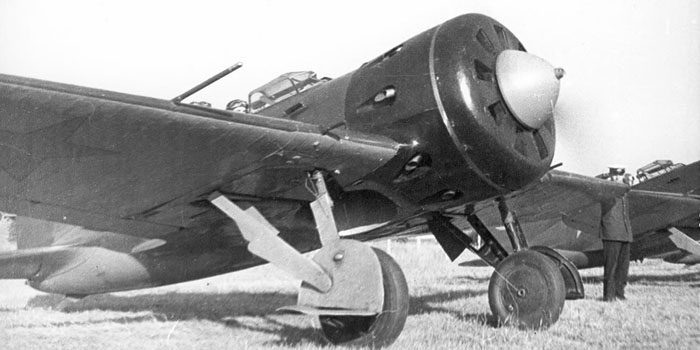
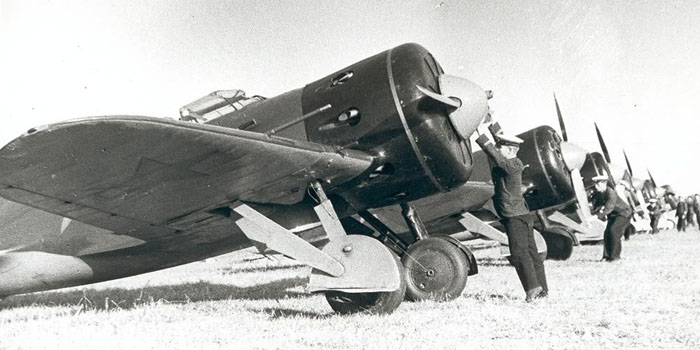
The I-16 Type 5 was mass-produced at GAZ-21 in 1936 and 1937, plus some built in 1938.
Left:
These I-16 Type 5 of the Baltic Fleet were photographed in June 1939 but built in 1936-37.
These planes are well representative of the livery with olive-green uppersurface and medium grey-blue undersurface, with black engine cowling.
The red star under the wing shows a thin black outline. The numbers were usually put on the rudders, usually of 1 digit or two digits rarely exceeding 15, and were often coloured according to the squadron within the regiment.
The propeller was unpainted on the front face of blades, while the rear face was painted black for the outer 3/4 of its length, with the inner 1/4 unpainted. The spinners can be black or painted of other colors, according to the regiment and to the squadron.
The canopy frames were usually of unpainted metal.
Note the black landing gear legs, wheels and inner faces of covers, while the bays were of the color of the external undersurfaces.
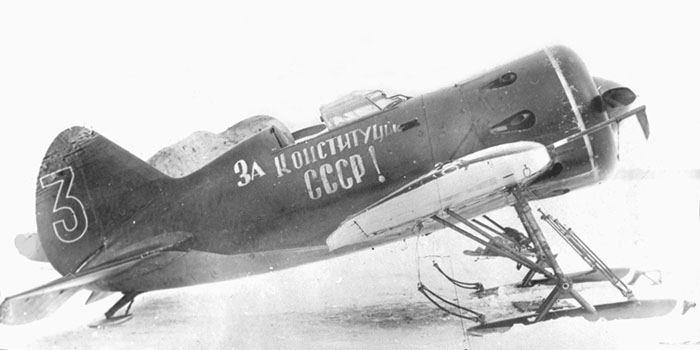
Ski-equipped Type 5 during the Winter War around December 1939.
Apart for the slogans, the painting likely was the original one of 1936/37: in facts, no difference of shade is visible between the metallic and fabric skinned parts of the undersurfaces.
In 1937, the standards of painting the Soviet military planes were modified by the gradual introduction of new paints:
- AE-x paints were oil enamels for external metal surfaces, resistant to atmospheric agents; they usually were utilized on a layer of ALG-1 yellowish primer, but could be utilized on unprimed metal too;
- AII (or A 2nd) colors were nitrocellulosic lacquers; they could be utilized on wooden and fabric surfaces, primed by a layer of yellowish nitroputty and/or aluminum paint, and on metal surfaces over some primer (usually ALG-1 zinc-chromate yellowish paint).
 AII Z gloss camouflage green
AII Z gloss camouflage green
 AE-9
gloss light grey (for metal) and AII light grey (for wood/fabric)
AE-9
gloss light grey (for metal) and AII light grey (for wood/fabric)
 AII aluminium
AII aluminium
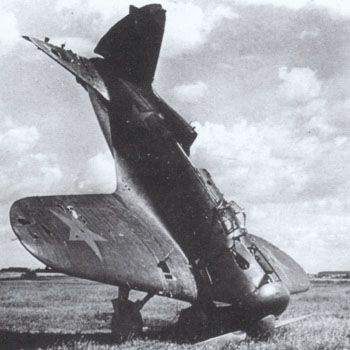
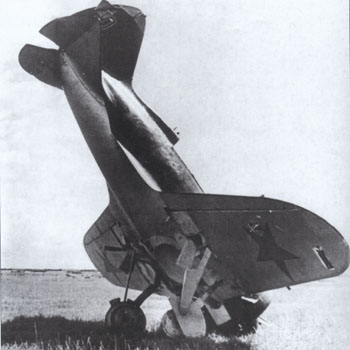
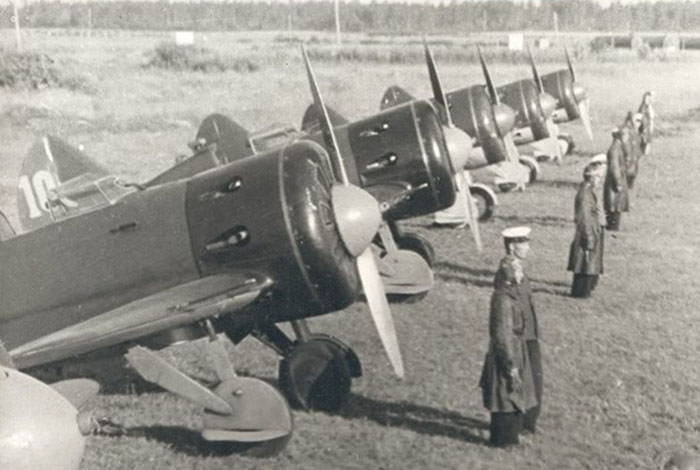
This photo shows a line including both I-16 Type 5 (the closer two planes) and Type 17 (the last 3 planes). The photo allows to compare their painting:
-
the shade of 'protective' hasn't changed in darkness, while the hue of the newer planes painted with AII green should be a bit more green and saturate than the older color;
-
the difference between the early blue of 1936-37 and the much lighter AE-9 of the newer planes, well visible on the landing gear covers, appears striking; the lower wooden parts of the newer planes, painted AII aluminum, are hidden on this photo;
-
the use of black on the cowlings of the planes built in GAZ-21 was abandoned in early 1938;
- the black painting of the landing gears of the older planes was abandoned in favour of light grey AE-9.
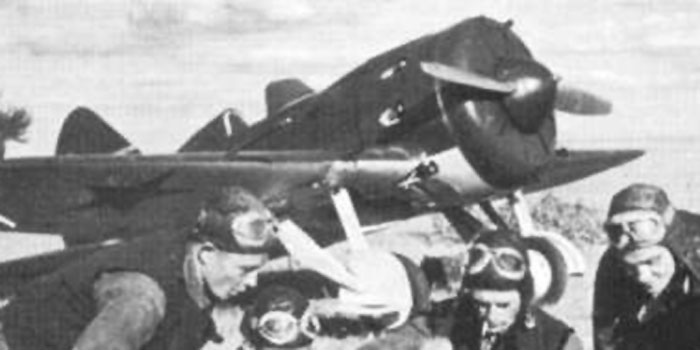
Although the manual for maintenance for I-16 describes to use AE-9 light grey on metal undersurface parts and AII light grey, that was very similar, on the fabric or wood-skinned parts, it is more than likely that all the planes came out of the factory with these parts painted with AII aluminum.

 Two
images of UTI-4 from a prewar movie. The different shade of metal panels
and fabric/wood surfaces is evident, as the metallic shining of aluminum
paint under the wings (reflecting the light doors of the landing gear)
and rear fuselage.
Two
images of UTI-4 from a prewar movie. The different shade of metal panels
and fabric/wood surfaces is evident, as the metallic shining of aluminum
paint under the wings (reflecting the light doors of the landing gear)
and rear fuselage.
Right: another I-16 from below shows silver on the outer wing panels, rear fuselage, tail and ailerons, and light grey on the metallic parts under the central wing plane and the cowling.
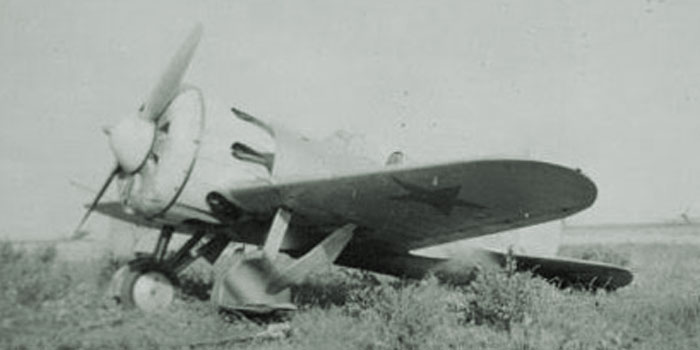
Although many planes as late I-15 bis and I-153 came out of factory in 1939 with full light livery (AE-9 gloss grey on metallic parts and AII Aluminum on fabric-skinned parts), it seems that all the few light I-16, found forthemost on training units, were repainted with the light colors in a second time after having been delivered with the usual green uppersurfaces.
The image shows also the direction of the exhaust stains on the landing gear doors, that appear oblique. This was because the legs and their covers rotated both inwards and rearwards during the retraction.
Of course, the versions with four separed exhaust pipes under the cowling show two stripes on each wheel cover, while the later ones with coupled pipes close to the wingroots had only one stains stripe each.
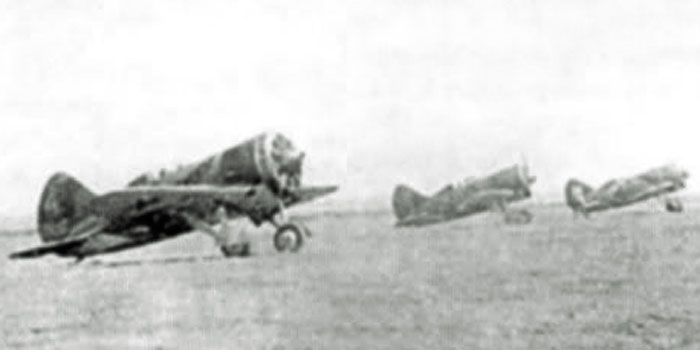
Photos of I-16 Type 5 of 56 IAP that fought in Khalkhin-Gol war against Japaneses, taken in July 1939. The planes show a camo made with light (grey?) blotches over the standard green livery, as seen on I-15 bis employed in the same war.
(from Voennaja Armada 2, 2001)

The production of M-62 engined Type 18 and Type 27 was made in 1939 and very early 1940; for some time, their production was made in parallel with the M-63 engined Type 24 and Type 28, that started in late 1939.
So, nearly all the Type 18 and 27, and a part of the Type 24 and 28, conformed to the standard of 1938-39 with AE-9 and AII Aluminum undersurfaces. Of course, it is possible that some planes were repainted in different way later.
I-16 Type 29 entered production in the second half of 1940 and was in production up to early 1941.
I-16s built between June 1940 and June 1941, that is late Type 24 and 28 and all Type 29, conformed to a new standard of painting:
- AII gloss green (perhaps a bit lighter than the color of 1938) and the new AII light blue for mixed construction planes; these colors were usable both on fabric and wood primed surfaces, both on metal primed surfaces;
- A-19f gloss green and A-18f light blue for all metal planes; they were somewhat lighter than the corresponding AII paints.
Some bw photos of Soviet planes built in 1940 and early 1941 (and perhaps even older planes) show a remarkable difference between wood/fabric skinned parts, that appear darker, and metal parts, that appear lighter. This is true for other mixed-construction models too, including MiG-3, Il-2, Yak2/4 and other ones (but not for I-153). Besides the difference becomes more and more visible in photos with the visible ageing of the plane.
A possible explanation is that AII colors were used on fabric-skinned parts and A-18/19f on metallic parts, that were painted separately before being assembled.
Other photos of I-16s of that timeframe don't show these differences; these planes were certainly painted with AII paints on both materials.
 AII gloss camouflage green
AII gloss camouflage green
 AII gloss light blue
AII gloss light blue
 A-19f gloss green
A-19f gloss green
 A-18f gloss light blue
A-18f gloss light blue
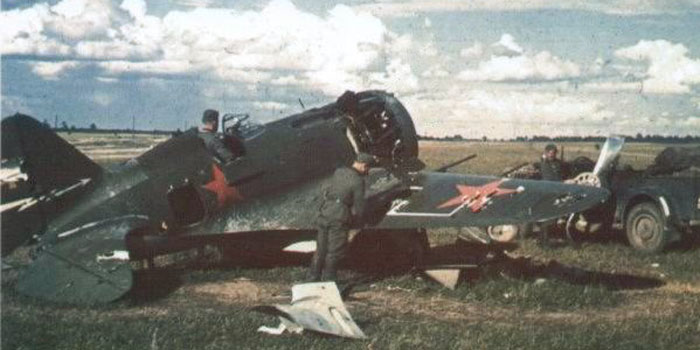
A rare color photo of an I-16 Type 28 taken by Germans.
The shade of green shown appears darker than the real one due to the characteristics of the German color photos of the time.
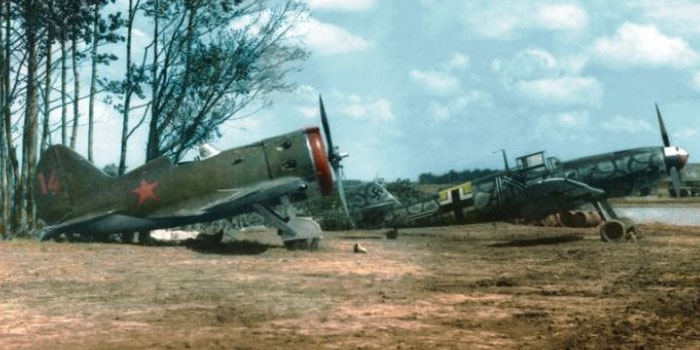
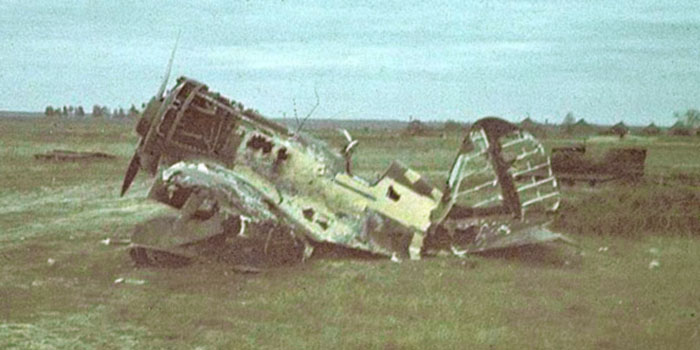
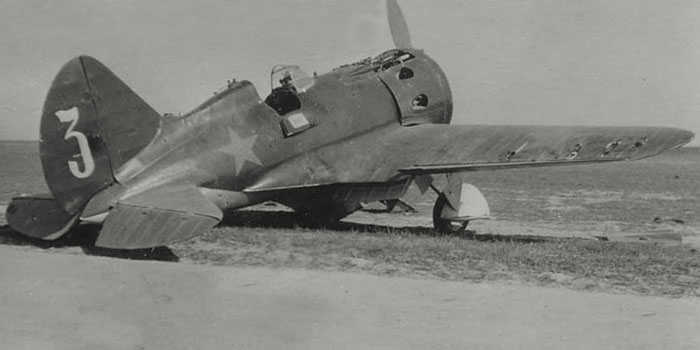
A photo of an I-16 type 24 with some damage.
Not all photos show difference between the shades of metal and fabric-skinned parts. On this photo, it seems that the same paints were used on both materials.

Some new temporary polychromatic camouflages were experimented on some I-16s and other planes during the summer of 1940, but, despite the good success obtained in masking planes, the idea wasn't adopted mainly for the difficulty to provide the huge amounts of new paints to the units.
To know more, go here
New instructions for the camouflage of military planes were published by the NKAP (the Ministry for Aeronautical Industry) in spring 1941, based on the experiments made with polychromatic camouflages in 1940. The instructions were scarcely applied for the lack of supply of paints and for their complexity.
These instructions considered 3-colors camouflages for fighters, and 4 and 5 colors camouflages for larger planes.
The colors prescribed for fighters (at least, one of the possible combinations) were sand 1(probably similar to AMT-1 but glossy), yellow 3 (intended as a sort of khaki drab, somewhat lighter and more yellowish/brownish than green AMT-4) and black 6. Undersurfaces had to be painted in light grey, probably AII light grey, similar to AE-9.
Centre: presumptive chips of the colors, all glossy.
Left: sketch of spring 1941 of one of the possible templates to camouflage I-16s (pattern not identical to that of the photographed UTI-4).
 sand 1
sand 1
 yellow 3
yellow 3
 black 6
black 6
 AII
light grey
AII
light grey

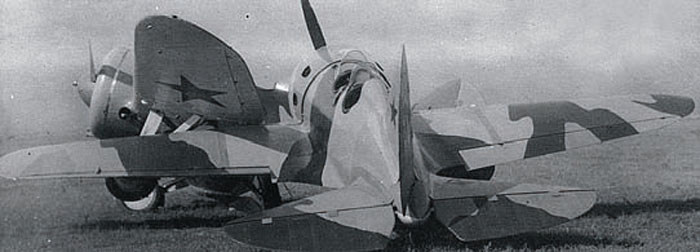
These UTI-4s were photographed on 21 June 1941, they were both built in Zavod 153, that continued to build UTI-4s up to 1943.
This camouflage could have been applied to a limited number of Type 29 too.
http://massimotessitori.altervista.org/sovietwarplanes/board/index.php?topic=1809.15
http://scalemodels.ru/modules/forum/viewtopic_t_954_start_300.html
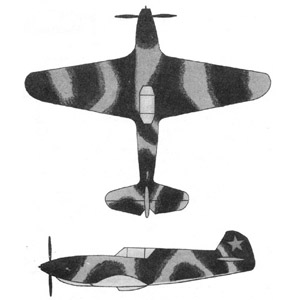
On 20 June 1941, the last day of peace, the NKAP (the Ministry for Aeronautical Industry) ordered to paint all planes with a new standard camouflage within one month.
Already existing planes with uniform green uppersurfaces had to be added with matt black (A-26m oil paint for metal planes, and AMT-6 nitrocellulosic lacquer for mixed construction planes). Undersurfaces presumably preserved the original finish.Prop blades were now fully painted black.
The order of June 1941 changed the national marks of planes too. Red stars, of plain type or with thin black outline, were now placed in four positions: on the tail sides and under the wing surfaces.
A month later, it was ordered to add a further red star on each side of the fuselage, raising the total to 6. This positioning was maintained up to the end of the war.
When compared to prewar standard positioning, one can note the deletion of the stars over the wings, and the introduction of new ones on the tail sides.
The new directive was released contemporarily with the war outbreak, when the frontline units had other things to worry about.
Many I-16s were not repainted and maintained the prewar livery even much after the war's outbreak.
 AMT-4
green
AMT-4
green
 AMT-6
black
AMT-6
black
 AII
light blue
AII
light blue
 AMT-7
light blue
AMT-7
light blue
For newly built planes, the instructions said to utilize matt light blue for undersurfaces (not specified what type of paint, but all previous light blue paintings were gloss, so they have to be A-28m for all-metal planes and AMT-7 for mixed construction planes).
Despite their name (M= matt), AMT colors were semigloss when new, and turned to matt finish with ageing.
AMT-6 black was not as dark as the glossy black utilized for markings, because the black outlines of the stars are often distinguishable in photos even on AMT-6 bands.
While AMT-4 and 6 were codified in July 1941, AMT-7 light blue was codified in August 1941, and is not mentioned on earlier manuals; earlier AII gloss light blue remained in use in parallel with the darker AMT-7 in the first year of war.
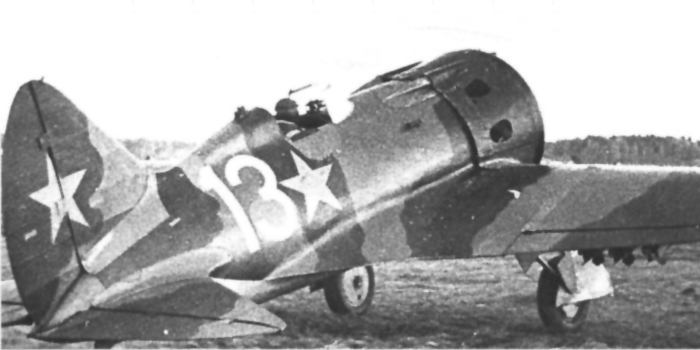
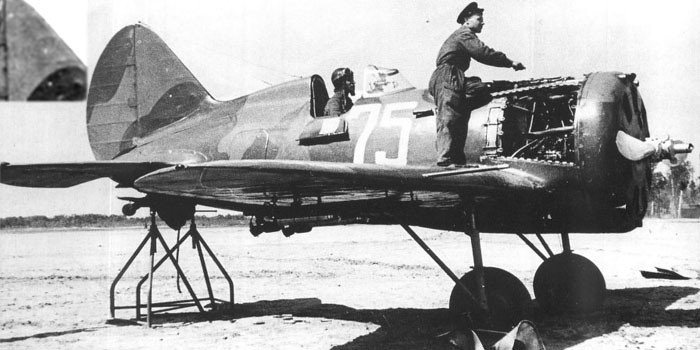
Many examples of I-16s with disruptive camouflage are known.
Sometimes it was obtained by overpainting with black the previously uniform AII gloss green uppersurfaces; other times, the plane was fully repainted with semimatt AMT-4 and AMT-6 paints.
The scheme of such bands often seems to have resemblance to the NKAP 1941 template, sometimes simplified (noticeably with the deletion on half-ball on the rear fuselage, or the fusion or omission of bands on the nose) to match the shorter fuselage.
If the photo of the plane of interest shows some resemblance to the drawing aside, this could be taken as a likely base to complete the parts not visible on photos.

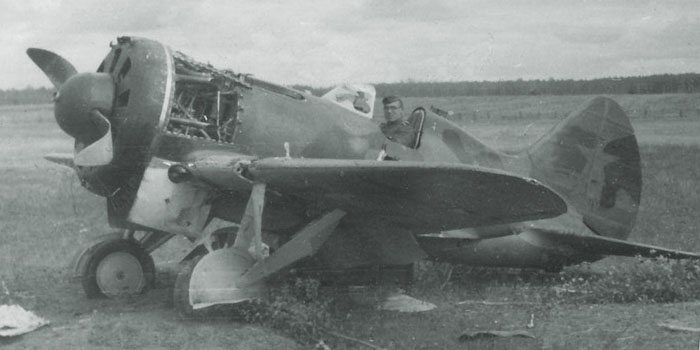
Not all the camouflaged I-16s fit with this drawing.
On the photo aside, the disposition of blotches on this plane doesn't match the NKAP template and it can't be of big help.

Many I-16s preserved the prewar livery much after the war's outbreak.
Even if I-16s were fully repainted after the start of the war, they were not always camouflaged.
Some examples of uniform green I-16 still can be found in 1942 or 1943.
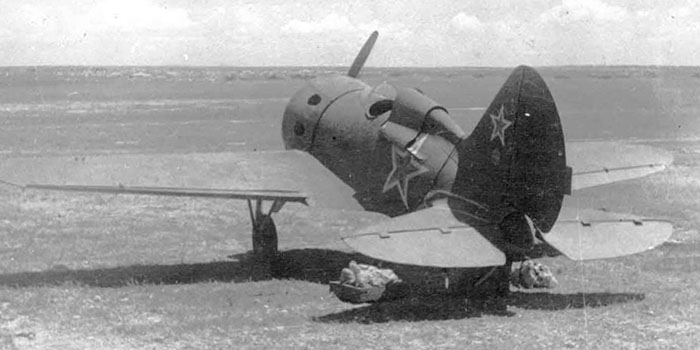

In winter 1941/42, and possibly 1942/43, many Soviet planes received a winter camouflage over the standard one.
The most common solution was the use of a layer of MK-7 white distemper on all the upper and side surfaces, leaving the red stars visible. Often numbers were repainted in red, black or other colors visible on the white background.
The white distemper layer was very matt, and could appear thick and uniform or discolored, or roughly painted with visible brush strokes.
This paint was intended to be washed off in spring, but often the underlying factory paints were ruined after washing it and the planes had to be repainted with the temperate camouflage again.
Some planes were painted with standard not washable white paints and appear more glossy and uniform, as the second plane of this line.

Some Soviet planes seem painted with an aluminum winter camouflage, instead of white.
Someone suggested that this could be an effect of froze and low sun, but some images are very convincing, particularly if they include other planes that don't appear painted aluminum under the same conditions (as the famous MiG-3 n.12 of 12GvIAP).
It is reported that a Soviet directive of the time forbidden to use aluminum paint as a winter camouflage, but this could confirm that someone was just doing this.

Another solution was to paint white only limited bands on the plane, obtaining a disruptive camouflage that let see the green and/or black areas of the temperate camouflage.
Often the engine and cockpit areas were avoided in white repainting, because they had to be accessible for maintenance and to the pilot without having to wait for the drying of the paint.
Another camouflage that worths a brief citation is the one used in the Soviet Far East in 1942-43: it is thought to have been made by AMT-4 green and AMT-1 light brown separed by AMT-6 black thin lines.
In winter, black lines could have been replaced by white lines.
In some cases, it seems to have involved some extra colors, probably the older and darker AII green left as a base.
 AMT-4 green
AMT-4 green
 AMT-1 light brown
AMT-1 light brown
 AMT-6 black
AMT-6 black
 AMT-7 light blue
AMT-7 light blue
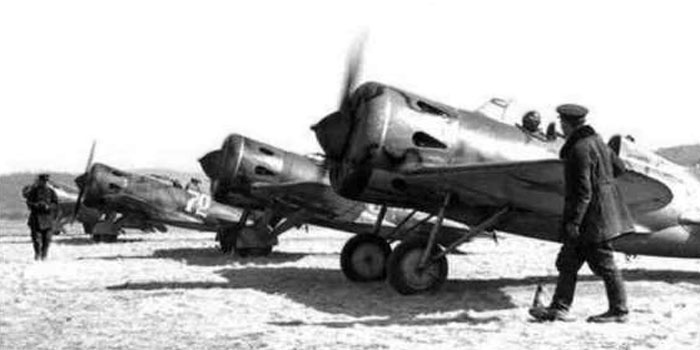
This camouflage was observed forthemost on second-line planes as I-16, UTI-4, I-152, MiG-3 and Po-2.
Someone defined it 'rice camouflage' for the resemblance to rice fields seen from above, but this wasn't its official designation.
http://massimotessitori.altervista.org/sovietwarplanes/board/index.php?topic=2150.0